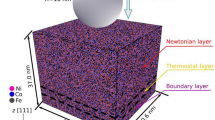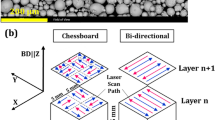The results of creep tests in the bending mode at 1150 – 1200°C for the Nb – Si – X alloy (X = Mo, Ti, Hf, Zr, Cr, Al) after hot isostatic pressing and after induction melting in the mode of directed crystallization are analyzed. It was shown that the creep rate of powder alloys is an order of magnitude higher than the creep rate of an alloy with a directed structure, which is related to the microstructural features of the alloy and the type of silicide formed in its structure. In all the alloys tested, the short-term bending strength at 20°C weakly depends on their composition and method of fabrication, while at 1300°C the alloy with a directed structure has the highest strength.





Similar content being viewed by others
Notes
Hereinafter, X = Mo, Ti, Hf, Zr, Cr, Al.
References
I. L. Svetlov, M. I. Karpov, A. V. Neiman, and T. S. Stroganova, “Temperature dependence of tensile strength of in-situ composites of the multicomponent system Nb – Si – X (X = Ti, Hf, W, Cr, Al, Mo),” Deform. Razrush. Mater., No. 10, 17 – 22 (2017).
F. Gang and M. Heilmaier, “Influence of directional solidification on the creep properties of a binary NbSi eutectic alloy,” JOM, 66(9), 1908 – 1913 (2014).
W. O. Soboyejo and T. S. Srivatsan, Advanced Structural Materials: Properties, Design Optimization, and Applications, CRC Press, Boca Raton (2006).
B. P. Bewlay, C. L. Briant, A.W. Davis, and M. R. Jackson, “The effect of silicide volume fraction on the creep behavior of Nb-silicide based in-situ composites,” MRS Proc., 646, 2.7.1 – 2.7.6 (2000).
P. R. Subramanian, T. A. Parthasarathy, M. G. Mendiratta, and D. M. Dimiduk, “Compressive creep behavior of Nb5 Si3 ,” Scr. Metall. Mater., 32(8), 1227 – 1232 (1995).
M. I. Karpov, V. I. Vnukov, T. S. Stroganova, et al., “Effect of silicon content on the microstructure and mechanical properties of niobium-silicon alloy,” Izv. Akad. Nauk SSSR, Ser. Fiz., 83(10), 1353 – 1361 (2019).
E. N. Kablov, M. I. Karpov, T. S. Stroganova, et al., “RF Patent No. 2557117, Niobium-based composite material, hardened with niobium silicides, and products made from it,” Byull. Izobr. Polez. Modeli, No. 20 (2015), published 07.20.2015.
Author information
Authors and Affiliations
Corresponding author
Additional information
Translated from Metallovedenie i Termicheskaya Obrabotka Metallov, No. 1, pp. 26 – 30, January, 2020.
Rights and permissions
About this article
Cite this article
Stroganova, T.S., Karpov, M.I., Prokhorov, D.V. et al. High-Temperature Deformation of Alloys of the Multicomponent Nb – Si – X (X = Mo, Ti, Hf, Zr, Cr, Al) System After Hip and After Induction Melting in the Mode of Directed Crystallization. Met Sci Heat Treat 62, 25–29 (2020). https://doi.org/10.1007/s11041-020-00508-1
Published:
Issue Date:
DOI: https://doi.org/10.1007/s11041-020-00508-1




